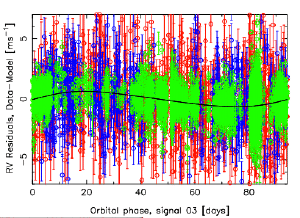Post
Devil in the Details
28 December 2012
Recently news came of five planets discovered around the star Tau Ceti. There are two reasons why this was sensationalized. The first is that Tau Ceti is relatively close (about 12 light years away), and second that two of the planets (tau ceti e and f) could be in the habitable zone.
Unfortunately, the way the story is told, it would seem we’ve not only found these planets, but have confirmed that two are habitable. We even have artist sketches of these new worlds. All that remains is to start packing our rocketships for the expedition.
In reality, the images we have of these planets look like the figure below. It is a plot of the measured motion of Tau Ceti relative to our instruments, with a best fit curve that resembles the periodic motion of a planet. If you look at the original paper you get a very different picture of these planets and what the authors actually found.1
 Tuomi, Mikko, et al.
Tuomi, Mikko, et al.Finding planets by watching the motion of stars is extremely difficult. The gravitational effect of a planet on its star is so small that basically you have to measure the star’s motion down to a speed of a meter per second, which is slower than human walking speed. Of course there is a lot of stellar motion that is faster than that, such as solar flares, star spots, and other random motion that is lumped together as “jitter”. To find the planetary signal in the jitter noise you have to do a great deal of number crunching. Of course you have to be very careful that our number crunching doesn’t yield a signal that isn’t really there. It is kind of like how you can see images such as faces in random patterns, even though they aren’t really there.
What the authors were doing was testing new methods of finding planetary signals. They did this by putting artificial planetary signals in the data of tau ceti to see if their methods could find them. It turns out that their methods worked quite well. It also turned out that when they analyzed the raw data itself they found evidence of five planets. As you can see from the figure, though, the data is very noisy, so these are tentative discoveries. They also checked to see if the orbits of these planets are stable, and they appear to be. At least they couldn’t prove them to be unstable given the limits of their computing power.
So good science was done. The authors successfully tested a method of pulling planetary data from the jitter, and they’ve found possible evidence of five planets. But we shouldn’t start packing our bags just yet.
Tuomi, Mikko, et al. “Signals embedded in the radial velocity noise-Periodic variations in the τ Ceti velocities.” Astronomy & Astrophysics 551 (2013): A79. ↩︎